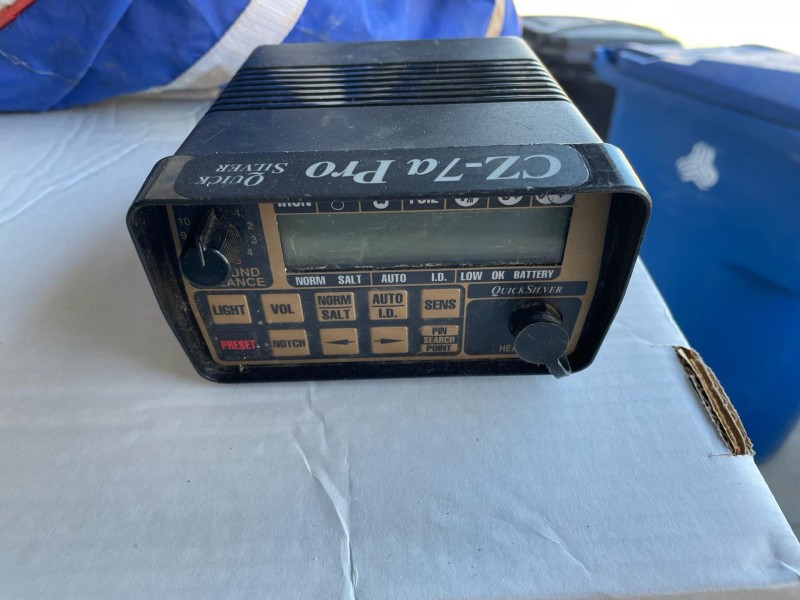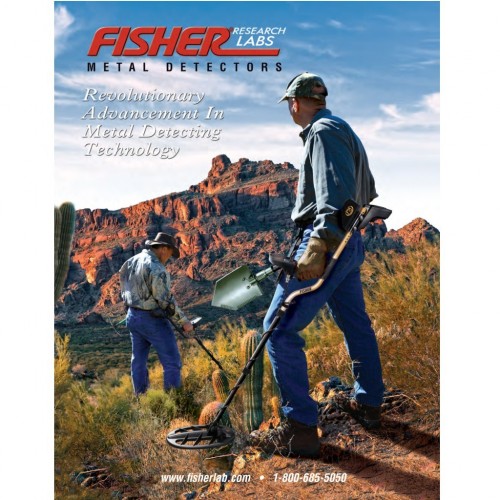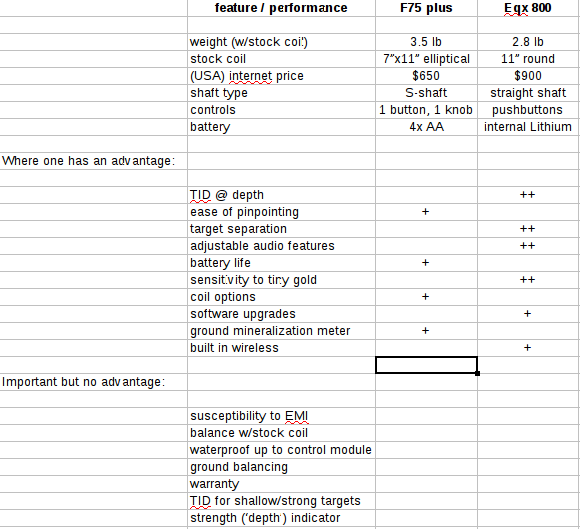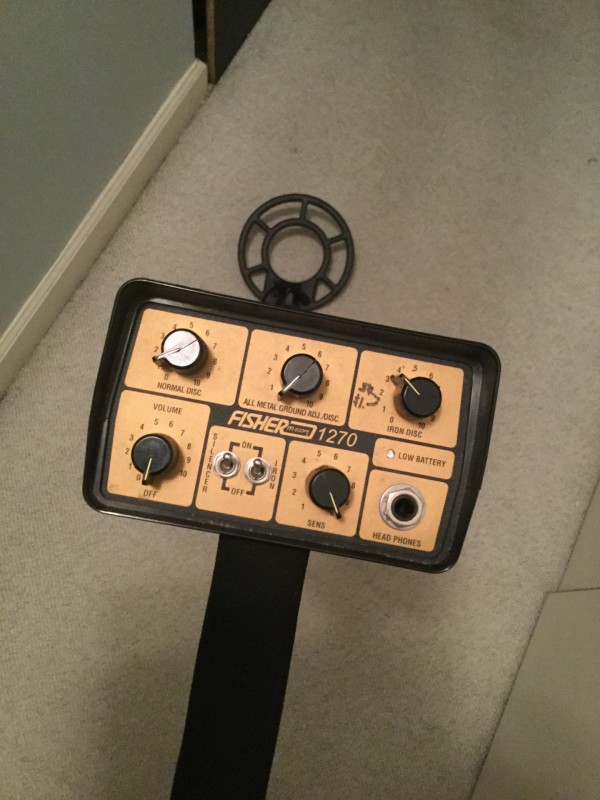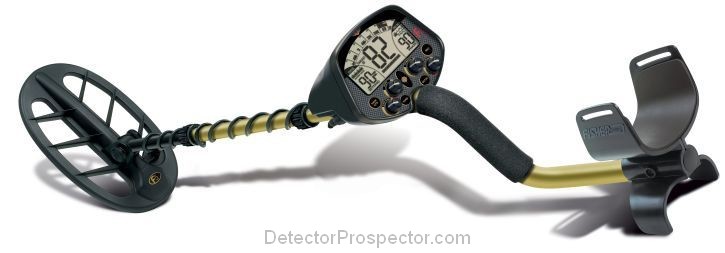Search the Community
Showing results for tags 'fisher detector'.
-
Someone is selling a Fisher 1212-X in NZ at the moment, looks mint condition, $50 NZD, about $30 USD at the moment with no interest in it. I'm very tempted to buy it. I've always wanted a classic, at the moment my GB2 is my classic but this looks the ticket. https://www.trademe.co.nz/a/marketplace/building-renovation/tools/other/listing/3380456910?bof=glG5OYbr I am guessing other than the coil it comes with I'd be stuck with no alternative coils though, no modern Fisher coils would work on it? I'd imagine its quite good at deep silvers with it's 4.2kHz frequency, 4kHz on my Multi frequency detector is a serious deep silver frequency. It looks pretty cool and for $50 NZD it's basically free. The other interesting thing is they marketed it with a lifetime warranty, in NZ it's illegal to say that is to the original owner, so technically it's still under warranty 🙂
-
Anyone have an idea what's a fair price for a decent 1266X ? So far I have found some for $375 ----$450🤣1st Texas says sorry no parts maybe that's the reason ??Can anyone know the difference between the 1265 x and 1266 x ?Looks like the conc.8" coil on the 1265 x would work better than the spider coil on the 1266 x ?
-
Can anyone tell me the main difference between this two fishers f-5 vs. f-70?Thank you gents.
-
Hey guys, an older friend of mine has a nice condition CZ70a Pro that he would love to hunt with again after many years but there is one problem: It is missing the upper shaft/stem/handle assembly. Apparently the handle broke off years ago and the upper shaft was lost or tossed. He has the control box and lower shaft. Yes, I know he could pouch it but he really wants to mount the box on a shaft. Unfortunately the mount used for this detector was only used on the CZ70, CZ70a and CZ70a Pro. I spoke to Fisher and they no longer carry parts fo that model. Does anyone have that the upper shaft/stem/handle assembly they would be willing to part with? I've attached pix for your reference of what he has left. Any help you can offer would be greatly appreciated. Lastly, I have spoken to Anderson Shafts about possibly making something but if I could find the actual part that would be very cool. Many thanks, Bill
-
Through most of 2020 I detected a large park which had been previously detected but still produced decent old coins for me. In one post I told of a well used path to a small waterfall which confused and frustrated me. The path (approx 150-200 m long) is right next to a creek ('stream' for you New Englanders 😉) and it was likely used for watering cattle in the late 19th and early 20th Century. The path was hard packed gravel and crushed stone, occasionl larger pieces of limestone, with soil filled in between all that aggregate. This path gave thick iron response to the Minelab Equinox and produced almost no coins. (I do remember one Zincoln -- I would.) Back then I tried both the 11" stock DD coil and the 6" DD with similar results. With both coils I recovered shallow (meaning mostly within the first 1" depth) lead bullets as well as brass casings. Most were 22 cal. but a few were larger and those in particular I was able to date at over 100 years old. My conclusion is that this path was used by hunters prior to it becoming part of the park. So in summary, lots of small iron (nails and wire), as many bullets and casings as I cared to recover, but no coins. And the recovered targets were mostly located in the top 1 inch. Some time after my report, kac suggested returning with the Tesoro Vaquero and 8"x9" stock concentric (the only concentric I have for it presently). He and dogodog recommended setting the threshold to where Zincolns just break up. I found out from the park caretaker that the path is scheduled to be covered over completely with a boardwalk so if I was ever going to return, I better make it quick. A week ago I took his advice as well as kac's and doggo's. But in two hours of hunting with the Vaquero I recovered almost nothing. One lead bullet somehow snuck past the threshold and I think I got an aluminum can base, but specifically no coins and practically no trash either. I had been committed to using concentric coils only and took my Fisher F75 with its tiny 3"x6" concentric as a backup. Returning the the vehicle I swapped out the detectors and returned for 2 more hours. I only use silencing discrimination (and silencing masking) when I have no choice so I set the F75 up in Default process, 4H (4 tones with nickel zone joining the high conductor coins in the highest tone). Low tone is 0-15 which is nominally the entire iron range. With this detector I decided to dig anything 'interesting', at least at the start. As was the case in 2020 I immeditately started recovering lead bullets and brass casings, all very shallow as before. Two more hours and still no coins. I gave up. At the far end of this wooded path there is construction of a new paved path in the open area of the park. (I've bitched many times before that I hate these backfilling-party upgrades!) For the last hour of this session I decided to search near that path, also at or close to where I had hunted previously. All the coins found that day (just two clad dimes and two copper Memorials) were found in that last hour with the F75 and its tiny coil. Here are the coins I found that day and the next day (described below): The next morning I returned to search several dirt piles -- the dirt having been removed ("scraped off") so they could backfill the walkway with crushed stone before paving with asphalt. That 2.5 hour hunt was exclusively with the ML Equinox 800 and 11" coil with my standard park/school coin hunting settings. The dirt piles produced only a clad dime -- what a disappointment. For the last hour I just searched part of the park I had hunted previously. One wheat penny was in the ground up trunk of a recently cut down tree (not surprisingly with damage from the blades of that tool). The other Wheatie was in along a path I'm pretty sure I had detected previously, but was less than 2" deep and thus sounded like a shallow Zincoln. (Lesson to self: Be careful what you mentally reject digging....) Oh, what's that other thing? Near the end of the first day in a dirt pile I got a signal in the nickel zone of the F75 (25-35 on the 0-99 scale) and thought maybe it was in fact a nickel. Imagine my disappointment when it turned out to be a 10kt gold child's ring weighing 0.43 g. (still about $10 in gold content at today's price). That's my first gold jewelry find since December of 2018. Ignoring the foil and pulltab ranges has its advantages... and its downsides. Finally, the non-valuable non-ferrous finds over these two days. The finds along the 'noisy' path to the waterfall (4 hours of the 7.5 hour total) are the lead bullets and brass casings, the aluminum bracket at far upper left corner, the chrome plated strap clamp (off womens clothing?), and the two items right above it -- one a small cap (but not bottle cap) and the other a small gear, possibly from a clock. To the right of those, also found along the wooded path, is heavy gauge copper wire wrapped around a fine gauge copper wire -- something electrical I guess. Everything else was from the rest of the (open) area I hunted over those two days. The tag with printing is religious and not old. Note the interesting toy cannon from a WWI(?) playset. I have no idea what those two embossed mating pieces (pot metal?) to the right of the toy gun are. That rectangle at the lower left is some kind of nametag, etc., not a buckle. Lower far right is a thick amber glass jar piece, probably part of a canning jar. Crown cap is pre-plastic liner era (I seldom find those as they rust away over 50+ years). Upper left is a decorative knob off of a piece of furniture. Finally the upper right -- what this was doing in a pile of scrape-off dirt at a park I have no idea. Here's a picture of a nearly identical piece I found googling: And some info on the company that made it: I'd much rather be showing you pictures of early coins, especially silver, and I'm sure you would, too, but the earlybird detectorists got those worms, leaving the decaying insects for me.
- 6 replies
-
- 14
-

-

-
- fisher detector
- tesoro detector
-
(and 1 more)
Tagged with:
-
I see a lot of comparisons between the Simplex and other mid price/mid level machines out there like the F75, AT Pro, etc. These days it may be possible to find a used F75, AT Pro, etc for the price of a new Simplex or close. Maybe even with an extra small coil. Like a 5” DD or a 5x8. Throw in buying an extra coil for the Simplex and maybe even price. Simplex I think only 2 year warranty, so that will be gone eventually , non user/field replaceable battery. There are tons of arguments either way, more coil availability, supporting a US company (although buying second hand), Garrett and Fisher get back to you quickly and service pretty darn good even if you bought used. I’m not a fan of my ACE300. It works. Just tones and buttons, display, not for me. So guessing the AT Pro would not be for me either. I love my F22 however. Guessing a bit different from the F75 but perhaps tones, VDI, etc is similar. I hear good things about how well balanced it is, was a benchmark in its day. I already have a 600 multi and Seahunter pulse and most of my hunting is in midwest parks and homesites so waterproof/salt not necessary. Although weatherproof is nice for rain! Would you get the used F75 or the Simplex? Better yet, would you trade a Simplex for an F75 if the right deal came along? (I have a Simplex already but waiting for warm weather). Would anyone even make that trade? Thanks for your thoughts.
-
I stumbled across this video of the F75 finding a silver coin deeper than the Equinox, and then he goes on to show the F75 performing better finding a coin between iron. What are your thoughts on this one? I never did bother buying a F75 even though a SE edition came up for sale extraordinary cheap nearby to me, my experience with my T2 had me thinking my Nox was better in almost all situations, was I wrong? I'm a bit puzzled by this video and I guess it could be soil conditions or something but I've found my Nox far better on deep silver than my T2 and I sure have experimented a lot on untouched in ground silvers.
-
Has Anyone Used The Fisher F5?
kac posted a topic in First Texas - Bounty Hunter, Fisher & Teknetics
Way back when I was shopping for a machine I had looked at the F5 and ultimately went with my AT Pro. Was always curious how the machine performed depth wise and overall as a coin and relic machine. I do prefer pots over buttons for the finer adjustment and that 7.8khz seems like a good frequency for bad ground. Poking around I saw that one the dealers has it on sale at $299 and they Nel makes a Superfly for it. https://www.metaldetector.com/fisher-f5-metal-detector -
I wish Fisher would make a digital CZ Quicksilver. Keep the same 5 & 15 frequencies with three options: 1) simultaneous dual CZ frequency, 2) a selectable 5 kHz single frequency, and 3) a selectable 15 kHz frequency. Four tone with adjustable tone break points for all the tones and the ability to change the tone pitch for all four tones. All four tones can be used anywhere within the TID scale. Keep the CZ modulation audio control. -99 to 0 to +99 TID. -99 to 0 is ferrous range. +1 to +99 for nonferrous. Non - normalized TID. 5 kHz runs 5 kHz target id, and 15 kHz runs 15 kHz target id. Dual is an averaged TID target id. Full range notching across -99 to +99. Sliding scale recovery speed. I'll dream up some more in a bit. HH Mike
-
I have an F22 with the stock 9” elliptical concentric coil that I like taking out every now and then. Mainly playgrounds and parks. I probably get most things within 6”. I’ve dug some good deeper signals occasionally but most good signals are within that 6” range which is adequate. I do use the iron audio occasionally, tot lots with mulch I dig everything above the weed barrier. I’ve been wondering about the Fisher alternative coils like the 4” concentric for some really trashy areas around shelter. I’ve also come across some posts where folks refer to a 5” DD coil but unclear which one. The F5 and F75 have that option but it is not on the charts as compatible with the F22. I’ve also seen aftermarket 5” DDs and other options. I figure depth loss should be minimal with better separation. Looking for insight from others that have used alternative coils on these detectors.
-
Well, i just got back from a short hunt detecting a park! Funny thing is, i only got to detect for around 20 minutes, and had just about finished up on the second of two clad and penny coin spills, when a young man (late 20's-early 30's) approached me, and asked if i had found a set of keys while out! I told him i had just started, and asked him a few questions about what, when, and where they were lost! He told me his name; (his first name was the same as my daughter's) and he took down my number to swap info! I said i would keep an eye out; he thanked me, and walked to his car! After exausting the coin spill a few minutes later, i watched as a woman (his mom) pulled up to help him! Something made me go over to offer to help search! I'm sure it was my Daughter's name the sparked that little voice in my head to offer, or just karma!?? Low and behold, the mom pulls out a metal detector that her husband just got recently! A Fisher F22! I showed her son some very quick basics on operation, but told him that we will most likely not be needing it! I said that the best tools are his memory of where he was yesterday, when he lost them playing frisbee golf! And his eyes! I offered to follow behind him in a zig-zag pattern, as he concentrated on his path! He had the Fisher swinging a few times, but i knew it would be useless for the task! And never turned my detector on! Upon his asking, i reassured him that our eyes and feet would be more productive! He had said that he though the keys would be somewhere on the last 3 or 4 holes they played, because that's where he remembers opening his bag the most! His mom took off on a different route looking herself! We walked nearly the whole course with me following the zig-zag, when he yelled out! As soon as he did, i could see the keys at his feet! He had already searched here this morning, and yesterday, but obviously missed them both times! (different lighting)! Third time was the charm! He was giddy, and high fiveing me! He had told me that the replacement key, and service fee for a locksmith to come out, would be $195.00 dollars, and it would hurt, to shell that out! He's the one who found the keys, but still thanked me several more times! He said he hoped that karma would give me a big find soon! I told him I've been there (loosing keys), and was glad i could help! When we got back to the cars, he offered some cash, but of course, i refused! His mom offered me a cuban pastry in a big box! Well, i didn't refuse that! It was guava! Yum!! After some more conversation, i found out that both her and my wife are both nurses, and were at one of the same hospitals in the past! And her ex-husband and i were both retired public safety workers! Her current husband was just getting into detecting! What a small world!! I told here that if she wanted to talk nursing with my wife, or her husband wanted some help with his detector, her son had my info! So that's my story for today! I got a better "treasure" than if i would have continued to beat the clad out of the ground! But i wouldn't mind cashing out some of that good Karma for a sparkling gold and diamond treasure at a beach sometime soon! 😂 👍👍
- 8 replies
-
- 15
-

-

-
- fisher detector
- lost or stolen
-
(and 1 more)
Tagged with:
-
I did some testing in my back yard to compare relative depths achievable in my soils with various coils on the Fisher F75. Caution: these are relative measurements specific to my soil conditions (including ferromagnetic mineral content and current moisture content). The purpose is merely to compare coil sensitivity for particular settings which push the detection depth limit under these conditions but otherwise should not be used as an absolute indication of how this detector with these coils mounted will perform under different conditions by other detectorists. My ground is of moderate mineralization, measuring 2-3 bars on the F75 depending upon exact location in my backyard and coil choice (higher reading for largest coils). Detector setup: Fisher F75 Limited (black) operating in motion 'all metal' (USA nomenclature, not Minelab's!), DST on, gain=99 (max), ground balanced, noise cancelled, threshold=0. I plugged Garrett GS2 headphones directly into the socket, i.e. 'wired' headphones. Test targets: 5" deep 95% copper Memorial USA 1 cent, 6" deep 25% nickel, 75% copper USA 5 cent ('nickel'). (These have been in the ground ~ 2 years.) Measurement meaning: because the coins are at fixed depth, in each measurement I raise the coil until I lose the signal in either left or right swing directions. That is, I require the target to sound off clearly as the coil moves from left to right and from right to left. I use wood blocks as shims with a least significant thickness increment of 1/2" (~1.3 cm). I estimate half that or 1/4" as the measurement's systematic uncertainty. Note that these measurements are intermediate ('hybrid') between full ground and an (full) air test. Coils tested: Fisher stock 7"x11" DD and 5" round DD (both included in the Limited/black model package), Coiltek 6" round DD prototype (built for Fisher F5 and operated successfully on my Fisher Gold Bug Pro), Mars 6"x10" DD Sniper, and Detech 13" round DD Ultimate. (I forgot to test the only concentric I have for this detector -- Fisher 5.5"x10" which is the stock coil on their F70. I'll do that later this week and add it to the table below.) Results: Summary/Conclusions: With the exception of the yellow-highlighted Coiltek prototype (which was not designed for the F75), the order of depth does reflect coil size. The Mars 6"x10" DD performs almost as well as the stock Fisher 7"x11" DD. The largest coil, the Detech Ultimate, is only a bit better than those two which likely reflects the considerable increase in ground it 'sees'.
-
Wanting to Take Bee for her maiden spin .....my mom’s nurse called and needed more supplies...Covid thing has been hard I have not seen her since it started .....But they tell me she is fine ....poor dear has dementia ....I am just Blessed I have a mom I can still see..... Of late I gotten where I like to do a Key West thing and watch the Sun sink over the beautiful Ocean And Sky call me a hopeless Romantic I do not care ...it is very empowering to me in a Spiritual way ....gives me hope for another Awesome day.. so I got home grabbed my gear notice the CZ6A was a B model I think it breaks down into three pieces for the briefcase.....I’m like this just gets better and better...Did some initial tests in the back yard got ground balance and different modes checked Out all systems go ......head to beach I only live 5 blocks away or less ...as a crow flies..... I had hunted a bit with the AQ on the last short sunset hunt and had pinned down an area that was starting to show promise this Area is not far From where Elvis and June Juanico had their first kiss on the Beach ...... I thought when I dug the Dime it was very deep and In the dying light ....I did not dress out for hardcore night hunt just a laid back seize the moment.... Get home and go Thru marker coins.... nickels dimes quarters This is what I found . Happy Trails jimpugh
-
I Remember driving to Atlanta for the dealer seminar when they introduced the Fisher 1266x and the CZ 6 . Like most of the dealers that attended we could not wait to get our hands on these two new units ........to say the least they were way ahead of their time ......depth and versatility unlike any unit on the planet made by the oldest Proudest Name in The Metal Detecting World ....... little did I know that that these units like my 1265X would become My new girls Betty and Nadine .....Betty the 1266X and Nadine the CZ6.......Booth were Mean and Dirty....but when they whisper that sweet Roundness in your Ear you knew you were in love and there would be no turning back. Yes the girls humbled many a proud hunter finding rare coins and jewelry at depths that others could not see at all .....nada nothing .....right behind them under their footprints....the girls had a way of teaching My friends a new art of Deep retrieval. To this Day I do not know how many detectors I have . And I really always have room for one or two more as long as they have the Right Stuff......some where lost along the Trail to the shores of Eldorado...Nadine ran off a couple times ....Well now she is Back with a New Name of fondness I will pour a smidge of Rum oN her coil and Christen her Aunt Bee.......let me tell you of Bee she is a Los Banos CZ6A from a little Lady From Tupelo Mississippi that only took her out to play once a year after the church supper on the grounds ......So she has Religion......Bee of coarse ......Need to go thru storage containers for more coils.... Happy Trails jimpugh
-
I just got word today that the new lightweight 15” coils are in production. I have a prototype for the T2 - it weighs 750 grams (26 oz.). MSRP is $149. If anyone wants one, I can get it shipped direct from FTP to you. It looks identical to the previous 15” coil - just made with different epoxy and much lighter.
-
-
-
-
Of all the different types of metal detectors, the two box is the oldest(?) but also one of the least used. Defintitely a detector for special situations, but with a couple possible exceptions, for the proper situation it's the best choice for the job. I'm aware of two standalone models still available new -- Fisher Gemini-3 and White's TM808. Garrett's Treasure Hound (see P. 43 of their latest catalog) and apparently a new kid on the block are attachments for specific standard (control unit + shaft + single coil housing) detectors. In particular what has me wondering (and confused) is the fact that the Gemini-3, operating at 81.92 kHz doesn't appear to have a gound balancing adjustment but the TM808 (6.5 kHz) does. I was under the (naive?) impression that low frequencies are less susceptible to ground mineralization but here it seems in practice, it's just the opposite. Any thoughts/explanations?
- 10 replies
-
- detector tech
- fisher detector
-
(and 1 more)
Tagged with:
-
I've been discussing qualities of Minelab lately (mostly in a negative light) and I decided to step back and ask myself why I use their Equinox 800 almost exclusively. It's worth starting out by saying I'm an old coin hunter (where 'old' is meant to refer to 'coin', although it also applies to 'hunter' 😁) the majority of the time, and and native gold hunter when the opportunity presents itself (not often enough). I've never detected near salt water and only occasionally (in shallow creeks) detected in water. Relics and jewerly aren't ignored but they typically only show up when I'm coin hunting, as peripheral bonuses. I want to emphasize from the beginning that I'm not reviewing/comparing these two for all conditions or even conditions that might apply to the average detectorist. This is all about me, well, about my conditions, particularly my hunting preferences/goals. Although that may seem selfish/uninteresting/unapplicable to readers here, in the least it might get you thinking about how different detectors 'weigh in' for your type of detecting. A Minelab GPX 5000 might be well worth the cost and backbreaking swings for someone, but if it doesn't fit your intended targets and locations then you wasted a couple thousand $ and may not even be maximizing your intended finds. I'll put some more caveats at the end, but basically I've broken this into three parts. The first are some quantitative/qualitative properties that are easily measured/stated. Next are the less quantifiable features/performances that mean the most to me. 3rd I list qualities that I determine are important but for which I don't see a significant advantage for either model based upon my usage. And finally I'll mention some of the things which most comparisons emphasize but for which I don't because..., well, you can read the reasons I give then. For completeness, the Fisher F75 is a 13 kHz single frequency IB/VLF detector whose initial model was released 11-12 years ago. Although I own the F75 limited (Black), I'm instead comparing the F75 plus since it has all the features I use at a lower price. The Minelab Equinox, both a simultaneous multifrequency and selectable multifrquency (5 kHz to 40 kHz) was released early 2018 with two models which continue to be the only ones available. The 800 model has more features. That is the one I own and compare here. One final clarification: in the second section, '++' means a feature/performance which is very important to me, and '+' means important, but less so. I emphasize 'to me'. That is, it might be a small or meaningless difference to many but it matters a lot to me. I suspect many of you have noticed I haven't included such fundamental features as waterproof/submersible and multifrequency/single frequency. The former is because it doesn't affect my hunting requirements. The latter is a bit more complicated. Rather than mentioning operating frequencies, I chose to emphasize the performance features. I don't really care what frequency/frequencies are being used as long as the detector performs (or outperforms) in the categories that matter to me. For example, simultaneous multifrequency improves the accuracy of the TID for deep/weak targets. The Eqx 800 got a ++ there. It should be clear that in the center section, which IMO is the most important, the Eqx 800 clearly outperformed the F75. My preference for the Eqx 800 as my primary and the F75 as my backup is thus justified. Update 1: based upon some questions that follow in this thread, I will do more detailed depth test comparisons to clarify my claim that F75 has more raw depth. I'll report those results in this thread as soon as I finish and will put another update on this post to call attention to it. Update 2: I've done a detailed hybrid (in-ground + air above ground) depth test in my test garden and those results can be found later in this thread. As such I've removed the 'raw depth' line in the above table since it's been superceded in much greater detail in the later post. If interested you should read that.
-
This is a prototype machine I acquired from Tom Dankowski many years ago. It looks just like any other 1270, until you examine the serial tag. This is a prototype that the old Los Banos Fisher had made to experiment with aluminum discrimination. The IRON disc is actually a “segmented” ALUMINUM disc that you can adjust with laser like accuracy. For example: Imagine you have your whole band of disc, from iron to silver, and you now place a magnifying glass over the aluminum portion of the disc. Now, if you are at a site that has an excessive amount of one certain kind of pull-tab, like a new style lift top, you can now disc it out and dig just the older style pull-tabs. You can also, eliminate most pull-tabs and dig nickels and all gold in that nickel range, tipping the odds in your favor to find more mid to large size gold rings without having to dig all pull-tabs.
-
Man, I need to keep up. First Texas introduced the Teknetics Patriot in 2017, a direct clone of the Fisher F70. I did not notice that they quietly discontinued the Fisher F70 in 2018, because they are still list on the Fisher website as current models. That and there were enough models left in stock that you can still find some new with some dealers to this day. But they are very near sold out now. Anyway, the F70 is definitely gone but not really, because you can still get it at a lower price as the Patriot. The Fisher F5 and Fisher F4 models have also been quietly discontinued, replaced by similar Teknetics and Bounty Hunter models at lower prices. These Fisher models also can still be found new at some dealers but are almost gone. Anyway, I updated the Metal Detector Database to reflect this oh so not late breaking news. That leaves the Fisher F11, F22, F44, F75, F19, CZ-3D, Gold Bug, Gold Bug Pro, Gold Bug 2, 1280-X, CZ-21, and Gemini 3 as current models. Of those only the F11, F22, and F44 are relatively new models, with half the current Fisher lineup being old carry over models from the First Texas acquisition of Fisher way back in 2006. Fisher F70 metal detector Fisher F5 metal detector Fisher F4 metal detector







